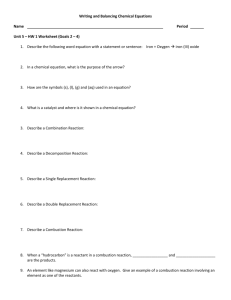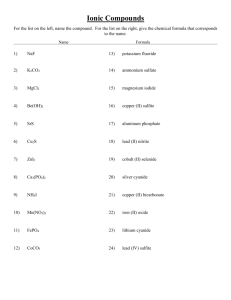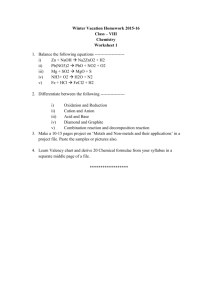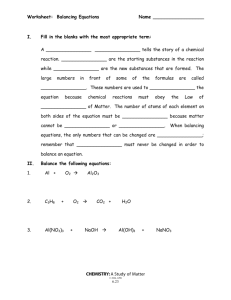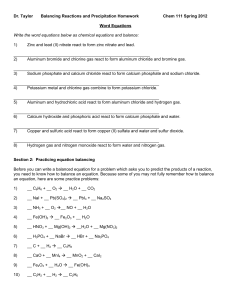Ch. 11 Worksheet
advertisement
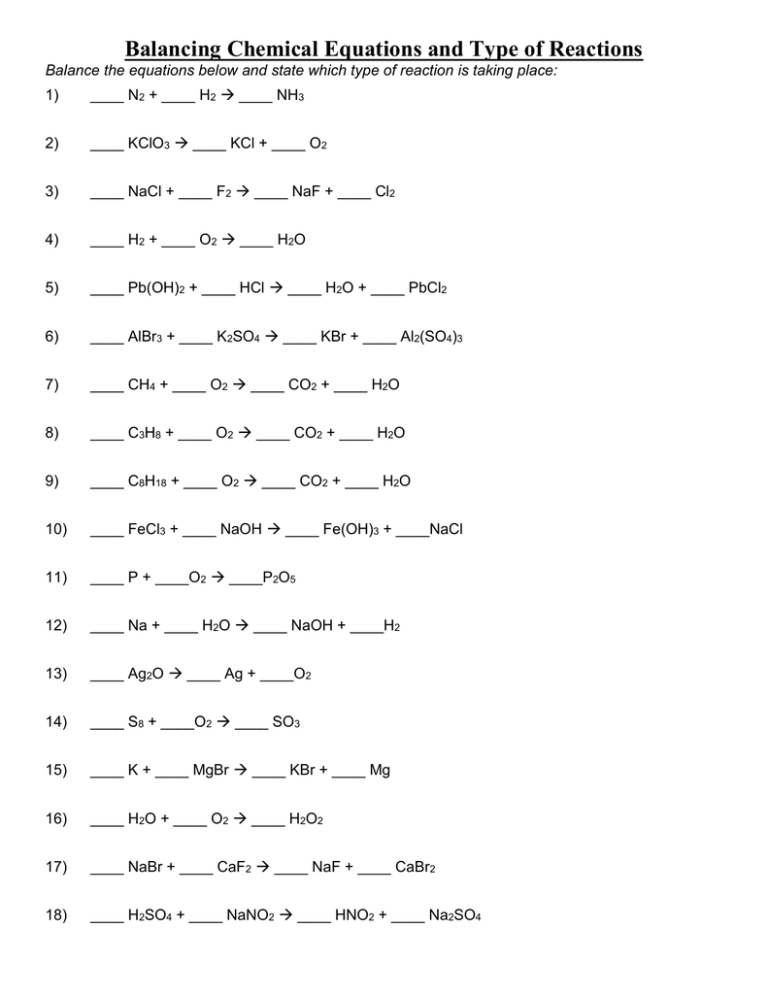
Balancing Chemical Equations and Type of Reactions Balance the equations below and state which type of reaction is taking place: 1) ____ N2 + ____ H2 ____ NH3 2) ____ KClO3 ____ KCl + ____ O2 3) ____ NaCl + ____ F2 ____ NaF + ____ Cl2 4) ____ H2 + ____ O2 ____ H2O 5) ____ Pb(OH)2 + ____ HCl ____ H2O + ____ PbCl2 6) ____ AlBr3 + ____ K2SO4 ____ KBr + ____ Al2(SO4)3 7) ____ CH4 + ____ O2 ____ CO2 + ____ H2O 8) ____ C3H8 + ____ O2 ____ CO2 + ____ H2O 9) ____ C8H18 + ____ O2 ____ CO2 + ____ H2O 10) ____ FeCl3 + ____ NaOH ____ Fe(OH)3 + ____NaCl 11) ____ P + ____O2 ____P2O5 12) ____ Na + ____ H2O ____ NaOH + ____H2 13) ____ Ag2O ____ Ag + ____O2 14) ____ S8 + ____O2 ____ SO3 15) ____ K + ____ MgBr ____ KBr + ____ Mg 16) ____ H2O + ____ O2 ____ H2O2 17) ____ NaBr + ____ CaF2 ____ NaF + ____ CaBr2 18) ____ H2SO4 + ____ NaNO2 ____ HNO2 + ____ Na2SO4 Word Equations Write the word equations below as chemical equations and balance. Then state the type of reaction. 1) Zinc and lead (II) nitrate react to form zinc nitrate and lead. 2) Aluminum bromide and chlorine gas react to form aluminum chloride and bromine gas. 3) Sodium phosphate and calcium chloride react to form calcium phosphate and sodium chloride. 4) Potassium metal and chlorine gas combine to form potassium chloride. 5) Hydrogen gas and nitrogen monoxide react to form water and nitrogen gas. Writing Complete Equations Practice For each of the following problems, write complete chemical equations to describe the chemical process taking place. Also state the type of reaction. Important note: There are a few physical processes on this sheet – remember, you can’t write an equation for a physical process! 1) When dirty water is boiled for purification purposes, the temperature is brought up to 1000 C for 15 minutes. 2) If a copper coil is placed into a solution of silver nitrate, silver crystals form on the surface of the copper. Additionally, highly soluble copper (I) nitrate is generated. 3) When crystalline C6H12O6 is burned in oxygen, carbon dioxide and water vapor are formed. 4) When a chunk of palladium metal is ground into a very fine powder and heated to drive off any atmospheric moisture, the resulting powder is an excellent catalyst for chemical reactions. Balancing Chemical Equations and Type of Reactions 1) 1 N2 + 3 H2 2 NH3 Synthesis 2) 2 KClO3 2 KCl + 3 O2 Decomposition 3) 2 NaCl + 1 F2 2 NaF + 1 Cl2 Single-replacement 4) 2 H2 + 1 O2 2 H2O Synthesis 5) 1 Pb(OH)2 + 2 HCl 2 H2O + 1 PbCl2 Double-replacement 6) 2 AlBr3 + 3 K2SO4 6 KBr + 1 Al2(SO4)3 Double-replacement 7) 1 CH4 + 2 O2 1 CO2 + 2 H2O Combustion 8) 1 C3H8 + 5 O2 3 CO2 + 4 H2O Combustion 9) 2 C8H18 + 25 O2 16 CO2 + 18 H2O Combustion 10) 1 FeCl3 + 3 NaOH 1 Fe(OH)3 + 3 NaCl Double-replacement 11) 4 P + 5 O2 2 P2O5 Synthesis 12) 2 Na + 2 H2O 2 NaOH + 1 H2 Single-replacement 13) 2 Ag2O 4 Ag + 1 O2 Decomposition 14) 1 S8 + 12 O2 8 SO3 Synthesis 15) 1 K + 1 MgBr 1 KBr + 1 Mg Single-replacement 16) 2 H2O + 1 O2 2 H2O2 Synthesis 17) 2 NaBr + 1 CaF2 2 NaF + 1 CaBr2 Double-replacement 18) 1 H2SO4 + 2 NaNO2 2 HNO2 + 1 Na2SO4 Double-replacement Word Equations 1) Zinc and lead (II) nitrate react to form zinc nitrate and lead. Zn + Pb(NO3)2 Zn(NO3)2 + Pb Single-replacement 2) Aluminum bromide and chlorine gas react to form aluminum chloride and bromine gas. 2 AlBr3 + 3 Cl2 2 AlCl3 + 3 Br2 Single-replacement 3) Sodium phosphate and calcium chloride react to form calcium phosphate and sodium chloride. 2 Na3PO4 + 3 CaCl2 6 NaCl + Ca3(PO4)2 Double-replacement 4) Potassium metal and chlorine gas combine to form potassium chloride. 2 K + Cl2 2 KCl Synthesis 5) Hydrogen gas and nitrogen monoxide react to form water and nitrogen gas. 2 H2 + 2 NO 2 H2O + N2 Single-replacement Writing Complete Equations Practice 1) When dirty water is boiled for purification purposes, the temperature is brought up to 1000 C for 15 minutes. No equation is needed, as boiling is a physical process. 2) If a copper coil is placed into a solution of silver nitrate, silver crystals form on the surface of the copper. Additionally, highly soluble copper (I) nitrate is generated. Cu(s) + AgNO3(aq) Ag(s) + CuNO3(aq) Single-replacement 3) When crystalline C6H12O6 is burned in oxygen, carbon dioxide and water vapor are formed. C6H12O6(s) + 6 O2(g) 6 CO2(g) + 6 H2O(g) Combustion 4) When a chunk of palladium metal is ground into a very fine powder and heated to drive off any atmospheric moisture, the resulting powder is an excellent catalyst for chemical reactions. Both grinding and heating are physical processes. Even if the atmospheric moisture is mentioned, boiling is still a physical process. No equation is needed.
